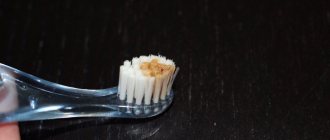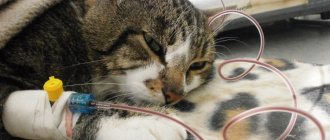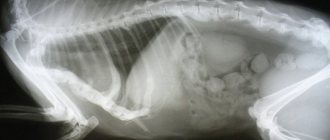Description
1-2 month old kittens, whose immune system has not yet developed well enough, are at greatest risk of contracting salmonellosis.
To avoid infection, it is recommended to give vitamin preparations to kittens of this age. Salmonellosis can occur in the following forms:
- Acute - characterized by an increase in temperature up to 40 degrees, the occurrence of vomiting, diarrhea, and tearing of the eyes.
- Subacute, in which the temperature rises above 40 degrees. The animal is lethargic and refuses to eat, which leads to severe exhaustion and death within a week after infection. A symptom of the subacute form is also watery stools, sometimes mixed with blood.
- Chronic - considered the most severe form. It is accompanied by alternating attacks of diarrhea and constipation. 3-4 weeks after infection, the pet may die.
The pathogen is small rods, the length of which does not exceed 4 microns. In drinking water they remain viable for 10-120 days, in soil - 9-10 months, in room dust - up to 18 months.
Reproduction of microorganisms occurs in the small intestine. They penetrate through the bloodstream and lymph flow into parenchymal organs, where they multiply again. Their breakdown leads to the release of endotoxins. By affecting the body, they cause poisoning and irritation of the gastrointestinal tract.
What symptoms are accompanied by
The main symptoms of the disease include:
- When cats are sick, they do not allow their bellies and sides to be touched. The animal hisses upon contact, tries to run away and may become aggressive. Poor appetite. The cat may eat small portions or refuse food completely. Most often, the desire to eat something is absent, the animal turns away from the food and does not try to approach the bowl. The pet may refuse to drink. This condition is more dangerous because After 2 days, irreversible changes begin. For kittens, the period is reduced to 4-6 hours.
- Increased body temperature. Indicators can reach 42 °C. Sometimes the temperature does not stay constant and can even alternate with loss of strength.
- Vomit. Maybe with foam. In severe cases, attacks can even be triggered by drinking water. Then urgent intravenous administration of solutions is required. Frequent licking may indirectly indicate nausea. Sometimes animals sit for a long time near a bowl of water.
- Apathy. The animal becomes lethargic, moves little, and does not want to play.
- Diarrhea. The presence of blood in the stool is an alarming sign. Both individual streaks and completely black feces are observed.
- Respiratory disorders. More often - cough. They indicate the imminent onset of death.
Causes
The main source of infection is raw poultry and farm animals that suffered from salmonellosis. You can become infected by consuming meat cat food, blood meat and bone meal, or cow's milk containing salmonella bacilli. Animals walking on the street or living in private homes are often infected by eating carrier mice.
Cats can carry the disease but not show symptoms. By releasing pathogens into the environment along with excrement, the carrier cat becomes a source of infection for other animals, and sometimes even humans. Salmonellosis during pregnancy leads to intrauterine infection of kittens and miscarriage. There is a danger of stillbirth or litter death during the first 1-10 days of life.
Predisposing factors that increase the likelihood of infection are:
- Failure to comply with basic hygiene rules for keeping pets.
- Presence of colds.
- The presence of an inflammatory process in the gastrointestinal tract caused by improper feeding.
- Severe helminthic infestation.
- The period of teeth change in small kittens.
- The period of transition of a kitten from breast milk to independent food of unsatisfactory quality.
Sources of infection, some features of the pathogen
Contrary to popular belief, Salmonella is quite common in the external environment. Thus, they are often found in the feces of completely healthy-looking animals, and such cases have also been recorded in humans. Sometimes pathogens are found on the skin or on the inner surface of the external auditory canal. Interestingly, “transporter” cats rarely get sick, but they can easily transmit the infection to other pets and their owners.
Tracheal collapse in a cat: causes and symptoms of pathology
The more often your pet receives raw food, the higher the likelihood of infection. The same applies to cases where an animal receives feed of unsatisfactory quality and/or of dubious origin. If in a bag of dry food you find pellets that are not very similar to food granules, but strongly resemble mouse droppings... In a word, you should not feed your pets this.
Symptoms
Salmonellosis in cats manifests itself differently and depends on the age of the pet. Kittens are characterized by rapid and acute development of the disease. In adults, it can take a sluggish form, in which there is a general malaise similar to mild poisoning.
In young cats, symptoms of the pathology appear 1-3 days after infection. The disease is accompanied by a sharp increase in temperature to 41 degrees, severe diarrhea and vomiting. Vomit has a viscous consistency; before vomiting, the cat releases a large amount of saliva.
The stool has a foul odor, contains blood, and is sometimes colored black due to the digestion of blood. A significant increase in temperature may be accompanied by the development of seizures.
Symptoms of the disease
In adult animals, the disease rarely develops acutely; most often the infection occurs latently or in the form of carriage. Salmonellosis is most severe in young cats and kittens.
Acute manifestations begin on the third day after infection; with large bacteremia, symptoms may appear on the first day. The cat becomes lethargic, refuses to eat, and sleeps almost constantly. At this time, body temperature reaches high numbers, up to 41 degrees. Against the background of prolonged low-grade fever, kittens may develop seizures.
The main manifestation of infection is diarrhea and repeated vomiting. This symptom is dangerous for the animal, as it leads to exhaustion and dehydration. Severe fluid loss can be suspected by your pet's sunken eyeballs.
You can also notice copious amounts of saliva and the appearance of purulent discharge from the nose and crusts. Feces are usually greenish in color, pungent-smelling, and watery. If proper treatment measures are not taken in time, young animals die quickly.
The infection can affect the respiratory tract, even leading to the development of pneumonia. Cats begin to breathe heavily and cough.
In the case of acute development of the disease, the death of the kitten occurs within a few days, in the subacute course - within a couple of weeks, most often from exhaustion of the body.
Some funny cats
When trying to palpate the abdomen, the cat actively resists due to severe pain. By releasing toxins, salmonella increase the permeability of the intestinal walls, which leads to the penetration of pathogenic and opportunistic flora into the bloodstream.
Other symptoms of salmonellosis include:
- The presence of purulent discharge on the nose and eyes.
- Heavy breathing associated with rapidly developing bronchopneumonia. Possible cough.
- Refusal to eat.
- Complete apathy to what is happening around.
Sick cats tend to avoid contact with people and other animals. They are irritated by bright light, so they always lie in dark places. The development of cough and severe respiratory failure indicates the imminent death of the cat.
Incubation period and development of the disease
The consequences of salmonellosis include dehydration, which develops against the background of diarrhea and vomiting. The possibility of pancreatitis, which is inflammation of the pancreas, cannot be ruled out. Sometimes kidney failure develops, to which young pets are most susceptible. Due to infection, the organ stops purifying the blood.
We invite you to read: Pug history of origin, features of maintenance and care
It is important to remember that salmonellosis is an anthropozoonosis. Simply put, by squeezing your furry, you yourself can become infected. The danger of this infection also lies in the fact that at least a third of cats (and dogs) do not show any symptoms at all, being classic carriers. If the infection “attacks” a cat with a weak immune system, then its manifestations will definitely not take long to appear. What are the symptoms of salmonellosis in cats?
Here are the main ones:
- Severe fever of intermittent type.
- Poor appetite or complete absence of it.
- Coma or lethargy.
- Severe profuse diarrhea, with feces often black from digested blood.
- Whenever you try to feel the stomach, the cat immediately begins to hiss and otherwise express its displeasure.
- Rapid development of sepsis. This is due to the fact that Salmonella toxins greatly increase the permeability of the intestinal walls, as a result of which pathogenic and conditionally pathogenic microflora can enter the general bloodstream.
This disease is especially dangerous if it affects kittens. They very quickly fall into apathy, their eyes droop literally within a few hours, their body temperature rises sharply, profuse diarrhea may begin, but diarrhea is not recorded in all cases of salmonellosis.
Who can your pet get infected from? Cats can serve as carriers of salmonellosis without being sick themselves. But almost all other types of domestic animals, including cattle, can “work” with them. Reptiles, especially turtles, also suffer from salmonellosis and can be its carriers.
Toxins accumulate in the body and affect the vessels of the intestinal wall, increasing its permeability. If the cat's body has insufficient resistance, endotoxins:
- cause areas of hemorrhage on the mucous membranes;
- provoke degenerative changes in organs - intestines, liver, kidneys, spleen;
- penetrate the body’s lymphatic system and general bloodstream, causing the development of sepsis - blood poisoning;
- affects all organs and systems - the brain, joints, lungs.
When bacteria infect all organs and tissues of the body, liver, kidney, and pulmonary failure develops and the death of the animal occurs.
The incubation period after infection ranges from several days to three weeks. The appearance of the first signs of manifestation may be acute or resemble the malaise of mild poisoning. It depends on the age of the pet. The infection is extremely dangerous for kittens, as they tolerate it extremely hard and can die on the second day of illness.
The disease is extremely contagious. If there are other pets in the house besides the cat, they must be isolated. In dogs, the symptoms that occur when infected are the same.
The course of the disease, its severity and the form of salmonellosis depend on the stability of the cat’s immunity.
Forms of the disease
There are acute forms of the disease, subacute and chronic.
The acute form develops when a large number of bacteria - pathogens and their toxins - enter the body. It is characterized by:
- a rapid rise in temperature to very high levels. It remains high throughout the entire period of illness;
- complete refusal of food;
- almost continuous watery diarrhea, vomiting;
- purulent discharge from the eyes and nose;
Vomiting is preceded by hypersalivation. Feces may contain blood and mucus.
Frequent vomiting and profuse diarrhea threaten dehydration and severe intoxication. In this condition, the animal may die already on the second day after the onset of salmonellosis.
The subacute form develops with the same symptoms only of less intensity. Dehydration may not occur as quickly as during an acute infection.
The chronic form of salmonellosis depletes the animal's body. When poisoned by bacterial waste products, purulent conjunctivitis, pneumonia, and anemia develop. Death can occur within a month after the onset of the disease.
Laboratory diagnostic methods
To make a diagnosis, it is necessary to conduct a bacteriological examination of stool for the presence of salmonella. In dead animals, secretions from parenchymal organs are examined.
Since the pathogen is not always detected in feces, additional methods are used to confirm or refute the diagnosis - microscopic, serological, biochemical blood and urine tests.
When making a diagnosis, an important task for the veterinarian is to exclude viral and bacterial infectious diseases that cause fever, diarrhea and vomiting in animals. Such diseases include:
- Plague of carnivores.
- Viral gastroenteritis.
- Flu.
- Helminthiasis.
- Poisoning with chemicals, poisons.
Types of Feline Salmonellosis
In addition, serology of the blood of a sick animal is necessary. Only after an epizootological, clinical and pathological examination can an accurate diagnosis be made. At the end of the diagnosis, stool is examined in a laboratory for the presence of salmonellosis.
- Acute. There is a refusal of food, an irritable state, followed by a change to depression. Throughout the entire period of illness, the body temperature remains within 41-42 degrees, while the eyes water and droop. Vomiting and diarrhea may be present. Death in coma occurs on the second day.
- Subacute. Stomach and intestinal upset occur, body temperature reaches 40 degrees, there is also a decrease in appetite or absence of it, and a sad state. The feces are liquid with bloody impurities. With severe exhaustion, the animal dies on the seventh day of illness.
- Chronic. All signs of a chronic course are similar to subacute, with only the addition of a decrease in hemoglobin in the blood and purulent inflammation of the eyes. With severe exhaustion, the animal dies 2 weeks after the onset of the disease.
Treatment
Lack of timely and adequate treatment leads to rapid progression of the disease. Therefore, if you suspect salmonellosis, you should urgently call a veterinarian. After confirming the diagnosis, he will prescribe the necessary medications and give recommendations regarding the further behavior of the owner of the sick cat.
During the first 1-3 days of treatment, you should not try to feed your pet. During this period, it is important to ensure that there is always a bowl of clean, fresh water near him. If necessary, the doctor will inject the cat with anti-toxic anti-salmonella serum with antibodies against certain types of pathogens.
First aid
First of all, the animal is prescribed medications to eliminate acute diarrhea and combat the pathogen. The following medications are used:
- Antibiotics and drugs of the sulfonamide group (Biseptol, Sulfalen, Oxytetracycline, Levomycetin). The course of antibiotic therapy is 7-10 days.
- Furazolidine is an antimicrobial agent with antiprotozoal action. It is used both for the treatment and prevention of salmonellosis, trichomoniasis, and eimeriosis.
- Antihistamines and glucocorticoids - the action of such drugs is aimed at protecting the liver from antibiotics.
Basic treatment
Along with the use of medications, treatment of symptoms of salmonellosis in cats includes the organization of proper nutrition and proper housing conditions.
When the animal’s condition has stabilized, the animal begins to be fed with pureed vegetables, boiled rice, and special food recommended by the veterinarian. After 3-5 days, when the cat is confidently recovering, its diet includes boiled chicken, liver, fish, and cereals. Instead of milk, it is recommended to use acidophilic yogurt.
To increase the body's defenses, the doctor prescribes vitamin complexes to the cat. The dosage and method of administration of such medications depends on the age of the pet.
Prevention
To prevent an animal from becoming infected with salmonellosis, healthy cats should not be allowed to come into contact with sick ones. It is necessary to regularly disinfect the premises, equipment, and care items.
To prevent the disease, it is important to provide adequate nutrition, carry out timely treatment of colds, gastrointestinal pathologies, and periodically use anthelmintic medications.
Animals that walk outside, eat mice, and often consume fresh meat must undergo timely vaccination. It is also necessary to vaccinate small kittens under 2 months of age.
To prevent human infection, after contact with a sick animal, you must thoroughly wash your hands and follow other sanitary and hygienic rules. If there are children in the family, they should not be allowed to interact with a sick cat.
Salmonellosis in cats is an infectious disease that affects the gastrointestinal system. Mostly kittens aged 1 to 2 months are affected, but in some cases the infection is also diagnosed in adult animals. Signs of salmonellosis are similar to manifestations of severe poisoning, helminthic infestation, and other infectious and viral diseases. Only a doctor can make an accurate diagnosis, based on the clinical picture and laboratory diagnostics. It is difficult to recognize the disease on your own. In the absence of qualified treatment, infected cats and kittens die from severe intoxication and exhaustion of the body.
Pathogen and routes of infection
S. typhi murium
A cat can become infected with salmonellosis by eating food contaminated with bacteria. Of particular danger is milk, meat or bone meal, which are obtained from animals that have recovered from salmonellosis. The cause of infection can also be contact with a sick animal or its excrement. Carriers of the infection can be domestic chickens, ducks, geese, as well as representatives of wild fauna - sparrows, seagulls, mice, rats, moles.
Important! Salmonellosis is a zooanthroponotic disease, that is, common to animals and humans. A person can become infected with this disease from a cat if the hygiene rules for keeping the animal are not followed. A cat sick with salmonellosis must be isolated from family members and animals living in the house, and kept in a separate room.
This is interesting: Symptoms of concussion in cats
Concept and causes of disease
The causative agent of salmonellosis is Escherichia coli, which belongs to the Enterobacteriaceae family and has more than 1,500 serotypes, but only 3 types of Salmonella are dangerous for the cat family. Escherichia coli is very mobile, the length of the bacterium is from 1 to 4 microns, it does not have capsules or spores. In the external environment, Salmonella is relatively stable: in water, soil and manure, the microorganism retains its viability for about 1 year. At low temperatures, Salmonella can remain active for up to 4 months. Disinfectants destroy the infectious agent within 1 hour.
The source of the causative agent of salmonellosis is meat and dairy products from sick farm animals or birds. Often the infection is contained in the egg of a waterfowl; in rare cases, healthy animals become infected from Salmonella-carrying cats that excrete E. coli along with their feces.
Salmonellosis in cats can occur during pregnancy, resulting in abortions and stillbirths. If sick kittens are born, their death occurs within a few days. Predisposing factors for the disease are considered to be:
- feeding low-quality foods that cause prolonged diarrhea,
- respiratory and gastrointestinal infections,
- decrease in the body's protective properties,
- change of baby teeth,
- worms.
Attention! Poor living conditions increase the risk of salmonellosis, especially if there are a large number of animals in one room.
Five mistakes that can lead to salmonella infection
- Keeping eggs warm. The first mistake leading to a dangerous illness is buying eggs stored outside the refrigerator. Salmonella rods love warmth: in comfortable conditions they multiply quickly. Salmonella can also multiply in the refrigerator, but not as quickly. With a small number of bacteria, the body can cope with a large number - no.
- Hygiene violations. If you break the shells of eggs and then simply dry your hands with a towel, you increase the risk of infection. Salmonella bacteria that were on the shell remain on the skin and are easily transferred to other foods. According to the World Health Organization, up to 69% of gastrointestinal infections are caused by poor hand washing. After contact with eggshells, you should wash your hands with soap and water for at least 14 seconds.
- Washing eggs intended for long-term cooking. If you are making a cake that will spend about an hour in the oven, do not wash the eggs intended for the dough before breaking. Salmonella is killed at around 70 degrees Celsius, so cooking in a hot oven will definitely kill the bacteria. Tap water, the temperature of which usually does not exceed 40 degrees, can transfer bacteria to other products or a sponge, where salmonella will successfully begin to multiply.
- Using raw yolks without heating the shell. Many housewives prepare homemade mayonnaise based on raw yolks. In this case, salmonella rods that were on the eggshell can get into the food. To avoid this, you need to pour boiling water over the egg, and only then break the shell.
- Using a wooden board to cut food. Although we associate salmonella infections primarily with raw eggs, the bacteria can also be found in meats (including poultry and fish), pates, cheese and even fruit juices. To avoid infecting your household with an unpleasant disease, you need to have a separate plastic cutting board for meat, fish, fruits and vegetables. A wooden board is not suitable - it is difficult to clean.
Signs of salmonellosis in cats
Penetrating into the animal’s body, the infectious agent rapidly multiplies, releasing endotoxins (waste products). As a result, inflammation forms on the intestinal mucosa. The incubation period from the moment of infection ranges from 3 days to 3 weeks, depending on the type of pathogen and the state of the cat’s immune system.
There are 3 stages of the disease, in which the symptoms of salmonellosis in cats vary significantly:
- Acute – characterized by a strong jump in body temperature (up to 42ᵒC), nervous excitement, and complete refusal of food. Small kittens lose motor activity and constantly lie down. Animals' organs of vision become watery and sunken. Diarrhea and vomiting may occur. After 2 days the animal falls into a coma and dies.
- Subacute – accompanied by severe digestive upset. The cat refuses food, there is bloody diarrhea and elevated body temperature (up to 41ᵒC). Salmonellosis in cats can be complicated by bronchopneumonia, in which case the animal experiences breathing problems and wheezing in the lungs. Sick pets die after 1-2 weeks from severe exhaustion.
- Chronic - has the same signs as the subacute stage, however, the death of the cat occurs 1 month after the onset of the disease. The chronic course is accompanied by purulent conjunctivitis and severe anemia.
Info! In some cases, the pathology occurs as a toxic infection (poisoning). With this form of the disease, the signs of salmonellosis in cats are less pronounced. Animals experience temporary indigestion, diarrhea (short-term), decreased interest in food, and a state of general depression.
Symptoms of salmonellosis
The incubation period (the period from infection to the appearance of clinical symptoms) lasts from 2 to 15 days (on average 7-12).
The development of the disease depends on the degree of virulence of the pathogen and the body’s resistance to it. There are acute, subacute and chronic forms. The main symptoms of Salmonella in a cat are diarrhea (catarrhal or hemorrhagic enteritis, i.e. inflammation of the small intestine), exsicosis (dehydration), and in a blood test - leukocytosis.
- The acute form occurs when a large number of doses of a pathogen or toxin enter the cat’s body. The form develops quickly and is manifested by refusal of food, high body temperature up to 42°C (may fluctuate throughout the course of the disease), frequent diarrhea (up to 15 times a day), vomiting, and depression. The animal is lethargic and apathetic. Hypersalivation (excessive salivation) often occurs before vomiting. The stool is watery, greenish in color with admixtures of mucus and blood, has a strong smell, and sometimes bloody diarrhea. Vomit contains remnants of unpoisoned food, bile, and hairballs. Pain in the abdomen when palpated (the cat hisses and is nervous). The eyes are sunken, watery, pus is released from them, the mucous membranes are pale and dry. Due to dehydration and severe intoxication, death is possible within 2-3 days. May be accompanied by damage to the lungs and bronchi, which is manifested by difficulty breathing and severe cough as a result of bronchopneumonia. In severe and advanced cases, convulsions and coma are possible. The acute form of salmonellosis often occurs in one-month-old kittens, since their immunity is not formed and it is difficult for the body to fight the infection.
- In the subacute form of salmonellosis, the temperature rises to 40°C, loss of appetite and diarrhea are observed. Dehydration does not occur as quickly as in the acute form. Death may occur within 7-15 days.
- The chronic form is characterized by the same symptoms, in addition, purulent conjunctivitis and anemia are possible. Death occurs after 2-3 weeks as a consequence of severe exhaustion.
Infection caused by Salmonella is dangerous due to the development of infectious-toxic shock and sepsis (caused by the penetration of bacteria from the intestines into the bloodstream), pancreatitis, acute renal failure, and dehydration.
shutterstock
First aid
Most owners of furry beauties do not know whether cats suffer from salmonellosis, and consider the signs of gastrointestinal distress to be ordinary food poisoning. If you suspect an infection, your pet should be immediately taken to a veterinarian; self-treatment at home is unacceptable. Salmonellosis in cats is an infectious disease that can be cured with antimicrobial drugs. Only a veterinarian can identify the pathogen and prescribe an effective antibiotic in the right dose.
Diagnosis of salmonellosis in a cat
To make an accurate diagnosis, a clinical examination of the animal is not enough; laboratory diagnostics are necessary. To identify the pathogen, a study of the feces of a sick pet is carried out; in case of a post-mortem diagnosis, it is necessary to conduct a bacteriological culture from the parenchymal organs of a dead cat.
The differential diagnosis excludes diseases such as canine distemper, helminthic infestation, influenza, intoxication with chemical and toxic substances, and viral gastroenteritis.
Principles of treatment
Treatment of salmonellosis in a cat should be comprehensive. At the first signs of the disease, it is advisable to use specific hyperimmune serum from recovered animals. Among antimicrobial drugs, antibiotics and sulfonamides (Biseptol, Levomycetin, Sulfalen) are prescribed; Furazolidone is highly effective. When cardiovascular failure develops, use glucose solution (20%), sulfacamphocaine, caffeine solution. The use of antiallergic drugs and glucocorticoids is also necessary.
How is the treatment carried out?
Pets are prescribed antibacterial drugs from the sulfonamide group, for example, Biseptol. Activated charcoal is used to remove toxins, and glucocorticosteroids are used as maintenance treatment. If required, antiemetic medications are prescribed. In addition, treatment of salmonellosis in cats involves transferring the animal to dietary nutrition. The diet should be based on easily digestible food. You will need to exclude milk and raw meat from the menu. It is recommended to feed your pet boiled fish, lean meat and rice cereal. In order to prevent re-infection, the animal’s toilet and dishes will need to be treated.
Prevention to combat salmonellosis in cats
Owners of four-legged friends should remember that salmonellosis is transmitted from cat to person, so precautions must be taken when caring for and treating an infected animal. Regularly treating your pet's area with disinfectants and thoroughly washing your hands with soap after each interaction with your pet will help prevent the transmission of infection.
Advice from the doctor! During treatment for salmonellosis, it is very important to increase the protective properties of the cat’s body, so sick animals require immunostimulating drugs. In addition, owners of furry creatures are obliged to improve the quality of life of their pet. The cat needs proper care (keep the animal clean, provide high-quality and balanced nutrition).
Sick cats are kept separately from healthy pets, and care items and equipment for infected cats are disinfected. Pregnant and lactating females are provided with high-quality food; kittens are introduced to new complementary foods with great care and gradually.
Salmonellosis is a serious infectious disease that poses a mortal danger to your four-legged friend. If you suspect a cat has a gastrointestinal disorder, you cannot hope that the ailment will go away on its own; you need to check the cat for salmonellosis. Only timely contact with a specialist will help avoid the death of your pet.
Salmonellosis in cats is a common disease. An animal can become infected with it from infected fresh meat. This intestinal infection is most dangerous for kittens. In this article, we reviewed the main causes, symptoms, methods of diagnosis and treatment of salmonellosis in cats.
Prevention goals
The main preventive goals are to feed pregnant and lactating cats, as well as kittens in the first months of life, exclusively high-quality food with a good shelf life. There is no need to give one-month-old babies food that is intended for adult cats, and vice versa: food intended for kittens in the first months of life is not suitable for adults.
Proper care and good living conditions are the key to excellent health and prevention of the development of dangerous diseases such as salmonellosis. At the beginning of feeding, you should not suddenly switch from one feed to another. This should be done gradually, replacing first one feeding, then two, and so on until a complete replacement of food occurs.
If there is a sick animal in the house, it must be isolated from healthy ones.
The room where the animal is located must be ventilated, disinfected, moistened as often as possible, and care items must be thoroughly washed after each use.
If you follow all the rules and contact a veterinarian in a timely manner, you can save the life of your beloved pet, who will be grateful to his owner for this until the end of his days.
The danger of contracting infectious diseases awaits pets everywhere. Due to their behavioral characteristics - catching a mouse or a street pigeon while playing - cats are highly at risk of contracting such a serious infection as salmonellosis from them. An infection that, based on its initial manifestations, can be mistaken for banal poisoning or another viral disease.
This is the insidiousness of salmonellosis. The manifestation of early clinical symptoms when infected with this infection is similar to the signs of a viral disease such as panleukopenia - “feline distemper”:
- the animal becomes lethargic, constantly hides in secluded places, almost never leaving them even to eat or drink;
- body temperature reaches critical levels;
- vomiting and diarrhea appear;
- There may be blood in the feces.
Salmonellosis in cats is a bacterial infection caused by Salmonella. The disease develops very rapidly and can be fatal. The characteristics of the pathogen, Salmonella bacteria, are that they are extremely persistent and survive in the most unfavorable environmental conditions. At low or high temperatures they remain viable for a long time.
For timely assistance and prescribing antibacterial therapy, it is very important not to confuse the disease. At the first suspicion of this bacterial infection, laboratory tests should be performed to confirm the diagnosis.
Causes of the disease
Feline salmonellosis is a bacterial intestinal infection caused by bacteria of the Salmonella genus. Doctors identify 20 different pathogens that can cause this disease.
Below are the main causes of the disease in cats.
- Eating raw meat contaminated with salmonella or poorly cooked cat food.
- Contact with an infected animal. A kitten can contract the disease from another cat. Older animals are less susceptible to this disease.
- Infection of kittens through the placenta can occur if an acute disease develops in the mother cat. The kitten may be born with congenital anomalies or dead.
- Eating rodents. Mice and rats can be carriers and transmitters of salmonellosis.
What should you know about salmonellosis?
Salmonellosis
– a disease caused by gram-negative facultative anaerobic bacteria belonging to the genus Salmonella. Species such as Salmonella paratyphi and Salmonella typhi, which cause “typhoid-like” forms of the disease, pose a danger to humans.
In addition, there are many types of salmonella that pose a danger to animals. They enter the body with contaminated food or water. Thus, in cats, salmonellosis can occur as a result of eating raw contaminated meat, milk and eggs, or contact with the feces of sick animals. Quite often, outbreaks of salmonellosis among cats occur in areas located near poultry houses, farms, meat processing plants, slaughterhouses, and burial sites for animal remains.
This is interesting: Why does a cat vomit blood?
Why is salmonellosis dangerous?
Cats can get salmonellosis several times in their lives. Their bodies do not develop immunity to the pathogens of this disease. In kittens, salmonellosis often leads to death. In adult cats, it can cause severe complications and pathological processes, which include:
- infectious-toxic shock - a condition that develops against the background of severe intoxication and a large amount of loss of fluid, electrolytes, and damage to the adrenal glands;
- dehydration – occurs due to excessive vomiting and diarrhea;
- pancreatitis - inflammation of the pancreas;
- Acute renal failure most often develops in kittens. Against the background of intoxication syndrome, the kidneys stop cleaning and filtering the blood.
Features of the clinical picture
Salmonellosis in cats can occur in acute, subacute and chronic forms. The first symptoms may occur within the first two days after contact with an infected animal or consumption of infected meat.
The main clinical manifestations of salmonellosis include the following symptoms:
- anorexia – refusal to eat. The animal refuses to eat the food offered to it;
- increase in body temperature to 41 degrees. A sick cat has a hot and dry nose;
- nausea and repeated vomiting. Vomit may consist of food debris, bile, gastric juice, hairballs;
- weakness, which is manifested by inactivity of the pet. The cat constantly lies down, sleeps, and does not walk around the house;
- profuse diarrhea. The stool may have a foul odor, foam, and streaks of blood and mucus can be seen in it. The animal goes to the toilet often, up to 15 times a day;
- A decrease in the amount of urine occurs due to dehydration of the cat.
Danger to others
Salmonellosis also poses a danger to pet owners. There is a risk of transmission of salmonella bacteria from an infected cat to humans. Therefore, after contact with a sick pet, you need to follow the rules of hygiene especially carefully:
- a sick cat should be isolated not only from other animals, but also from family members, especially children;
- disinfect those items that were used when caring for an infected cat;
- After handling a sick pet, hands should be washed twice with soap.
Even after treatment ends, the cat may remain contagious. Bacteria - pathogens - will be present in the feces. Her contact with other animals should be limited.
Category: Diseases and treatment
Salmonellosis
– a dangerous infectious disease for cats. Its causative agent is microorganisms of the genus Salmonella, and the source of infection is sick animals and bacteria carriers (they have no symptoms of the disease). Transmission of the infection usually occurs through consumption of contaminated food.
The main symptoms of the disease
The incubation period of the disease lasts from three to twenty days. The clinical manifestations of salmonellosis are very diverse, so laboratory tests are required to make a diagnosis. It is impossible to diagnose the disease only by external examination and focusing on the main symptoms.
There are several forms of the disease, each of which has its own characteristics.
1. Acute form. This stage is characterized by the following symptoms. After the incubation period, the animal becomes inactive and its appetite worsens. Body temperature rises to 41-42 degrees C. Frequent diarrhea and vomiting appear, which quickly leads to dehydration. With significant loss of fluid, cats' eyeballs become sunken. In the absence or improper treatment, the death of the animal occurs from exhaustion of the body approximately on the third day.2. Subacute form. It manifests itself as a disruption in the functioning of the digestive system. At the same time, appetite weakens and bowel dysfunction appears. The feces become greenish in color, with the presence of a sharp unpleasant odor, mucus and blood. There is an increased body temperature. The death of a pet can occur on the seventh to fourteenth day.3. Chronic form. With this form, an alternation of disturbances in the animal's stool occurs - diarrhea is replaced by constipation. Possible exacerbation of inflammatory diseases. Anemia develops. Death occurs on the twenty-first – twenty-eighth days.
Diagnosis and treatment
Laboratory tests should be performed to confirm the correct diagnosis. Stool is cultured on nutrient media to detect microorganisms. Blood and urine tests are also performed. For salmonellosis, treatment is primarily aimed at preventing fluid loss and normalizing stool. Antibacterial drugs are then prescribed. If the animal's condition improves, a light diet is also prescribed. You should not treat your animal at home! This can kill your pet. You should immediately come to the veterinary clinic for professional help. To prevent re-infection of the animal, the dishes from which the pet eats should be treated.
First aid for salmonellosis
Salmonellosis in cats is treated under the supervision of veterinarians. When the first signs of illness appear, the animal should be taken to a veterinary hospital.
Remember that trying to cure a cat of salmonellosis on your own is dangerous. She may die due to improperly selected therapy and complications that can only be identified by a veterinarian.
First aid can be provided by the owner of the animal. With its help you can slightly reduce the intoxication syndrome.
The main components of first aid are listed below.
Gastric lavage
Gastric lavage will help remove from the body the remnants of low-quality contaminated food that has not had time to be digested.
In order to rinse a cat's stomach, you can pour 20-40 ml of plain water at room temperature through a syringe and induce vomiting. To do this, you can sprinkle a little salt on the root of the tongue.
Please note that animals are prohibited from rinsing their stomachs with potassium permanganate. This substance can cause a burn to the esophagus and increase intoxication of the body.
Enema
To wash a cat's intestines, you can use a baby bulb with a volume of 50-100 ml. You need to rinse until clean intestinal water appears. You need to use plain boiled water at room temperature.
Sorbents
Sorbents are medications that help neutralize and remove pathogenic bacteria and their toxins from the intestines.
Crush half a tablet of activated carbon, mix with 5 ml of water and pour the medicine into the cat’s mouth through a syringe.
Drink
You need to give your cat water little by little and often. It is best to do this through a syringe. Every 15 minutes, pour 5-10 ml of plain water into it.
Treatment is prescribed by a veterinarian after examining and examining the animal. If the condition is severe, the cat may be kept in hospital at a veterinary clinic for several days. If the patient is feeling stable, the doctor describes the treatment plan, diet and tells the owners when to come next time for injections and IVs.
Treatment for salmonellosis consists of:
- dietary nutrition;
- antibacterial drugs;
- droppers with solutions to treat dehydration;
- corticosteroids;
- antispasmodics;
- antiemetic drugs.
Pet examination
To identify the causative agent of the disease, complications and to assess the functioning of the internal organs, the animal is prescribed an examination, which consists of:
- general blood test - carried out to identify a bacterial infection and assess the degree of dehydration;
- general urinalysis, which is needed to detect kidney damage;
- biochemical blood test - to assess the functioning of the liver, pancreas, kidneys;
- bacteriological examination of stool, which is needed to identify the causative agent of intestinal infection;
- ultrasound examination of internal organs, in which the doctor evaluates the shape and size of the liver, gall bladder, pancreas and kidneys;
Please note that an animal that has had salmonellosis can be contagious to other pets for a long time. After completion of treatment, he should be examined for the presence of Salmonella bacteria in the feces.
Salmonellosis in cats is a common infectious disease. It is most dangerous for small kittens, who can die due to intoxication syndrome and dehydration. Treatment is prescribed by a veterinarian. Before going to the veterinary hospital, you can rinse the cat’s stomach and intestines yourself, give it sorbents and drink. To make a diagnosis, examination of the animal may be necessary.
Diagnostics
It is unrealistic to make a diagnosis on your own; its manifestations are similar to those of other infectious diseases. Therefore, if you notice the above symptoms in your cat, you should immediately seek veterinary help. The doctor will order a number of diagnostic tests for your pet, which may include:
- general blood and urine tests;
- bacteriological analysis of blood taken from the animal’s ear vein;
- analysis of stool and/or vomit for the presence of Salmonellosis bacteria;
- analysis for the presence of pathogens in the food the cat ate.
During bacterial analysis, Salmonellosis is detected quite easily; when the material is inoculated in agar-agar and the samples are kept in a thermostat for 6-7 hours, the culture is identified using agglutinating sera. Thus, the diagnosis can be made within 24 hours. This allows you to start treatment in a timely manner and avoid death.










